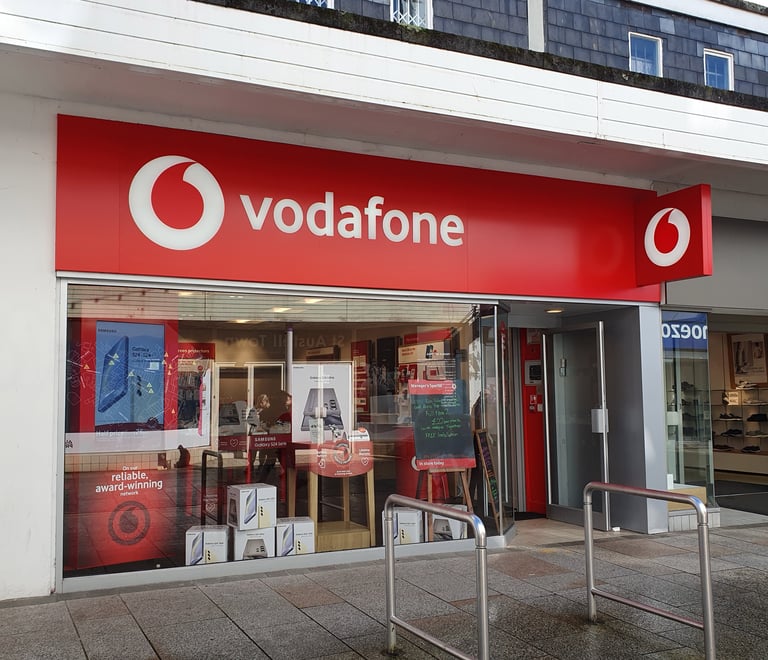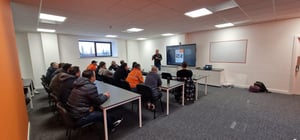Vodafone Group Plc (LON:VOD) today announced it’s results for the six months ended 30 September 2017.
Highlights
· Group total revenue down 4.1% to €23.1 billion, primarily due to the deconsolidation of Vodafone Netherlands and FX movements; operating profit up 32.5% to €2.0 billion; profit for the financial period of €1.2 billion
· Organic service revenue up 1.7%*; Q2 up 1.3%* (Europe 0.8%*, AMAP 6.2%*)
· Organic adjusted EBITDA up 13.0%* to €7.4 billion (9.3%* ex roaming, UK handset financing and regulatory settlements1)
· Free cash flow (pre-spectrum) improved to €1.3 billion vs. a €0.1 billion outflow in the prior year. Free cash flow was €0.4 billion vs. a €0.4 billion outflow in the prior year
· Raising full-year guidance for organic adjusted EBITDA growth to around 10% (previously 4-8%), implying a range of €14.75-€14.95 billion at guidance FX rates; FCF pre-spectrum to exceed €5 billion (previously ‘around €5 billion’)
· Vodafone India service revenues down 15.8%*, adjusted EBITDA down 39.2%*; merger with Idea Cellular progressing well
· Interim dividend per share of 4.84 eurocents, up 2.1%
Vittorio Colao, Vodafone Group Plc Chief Executive, commented: “In the first half of the year we have maintained good commercial momentum. Revenue grew organically in the majority of our markets driven by mobile data and our continued success as Europe’s fastest growing broadband provider. Enterprise revenues continue to grow, led by our Internet of Things (‘IoT’), Cloud and Fixed services, and for the second year running we achieved an absolute reduction in our operating costs. As a result, we are able to report a strong financial performance, with substantial EBITDA margin expansion and profit growth, and we are raising our financial outlook for the year.
In India competition remains intense. There are however signs of positive developments in the Indian market, with consolidation of smaller operators and recent price increases from the new entrant. We are making good progress in securing regulatory approvals for our merger with Idea Cellular and in monetising our tower assets.
In the second half of the year we will continue to implement our strategic initiatives, including fibre infrastructure expansion in Germany, Portugal and the UK; our entry into the consumer IoT market with the launch of “V by Vodafone”; and the ‘Digital Vodafone’ programme designed to enhance our customers’ experience, increasing revenues and cost efficiency.”
CHIEF EXECUTIVE’S STATEMENT
Financial review of the half year
On 20 March 2017 we announced an agreement to merge Vodafone India with Idea Cellular (‘Idea’) in India. As a result, Vodafone India is now excluded from Group figures, unless stated otherwise.
Financial results: Statutory performance measures
Group revenue for the first half of the year declined 4.1% to €23.1 billion, primarily due to the deconsolidation of Vodafone Netherlands following the creation of our joint-venture ‘VodafoneZiggo’, and foreign exchange movements. Operating profit rose to €2.0 billion compared to €1.5 billion in the prior year, reflecting operational leverage and the benefit of cost efficiency initiatives. Profit for the period was €1.2 billion, a substantial improvement compared to a loss of €5.0 billion in the prior half-year, which was impacted by a €5.0 billion net impairment of the Group’s operations in India.
Financial results: Alternative performance measures
Group organic service revenue grew 1.7%* (Q1: 2.2%*, Q2: 1.3%*). The slowdown in Q2 was driven by Africa, Middle East and Asia Pacific (‘AMAP’) (Q1: 7.9%*, Q2: 6.2%*) reflecting strong prior year comparatives, as well as by a lower contribution from carrier services. In Europe (Q1: 0.8%*, Q2: 0.8%*) the increased drag from roaming regulation in Q2 was offset by an improved underlying performance in mobile.
Group adjusted EBITDA was up 4.2% at €7.4 billion despite the drag from the deconsolidation of Vodafone Netherlands and adverse foreign exchange movements. Organic adjusted EBITDA grew 13.0%*, a significantly faster pace than service revenue. Excluding the negative impact of net roaming declines in Europe and the benefits in the UK from the introduction of handset financing and regulatory settlements in the period, organic adjusted EBITDA grew by 9.3%*1, with broad based EBITDA improvement in nine out of our ten largest markets. This growth reflected higher revenues and a decline in absolute operating costs on an organic basis as a result of the ‘Fit for Growth’ programme. Consequently, the Group’s adjusted EBITDA margin improved by 2.5 percentage points to 32.0%, or 2.8* percentage points on an organic basis (1.9* percentage points excluding roaming and UK handset financing/regulatory settlements).
Adjusted EBIT increased by 19.9% to €2.5 billion, with organic adjusted EBIT increasing by 51.9%*, driven by strong adjusted EBITDA growth and broadly stable depreciation and amortisation expenses.
The Group’s adjusted effective tax rate for the first half was 22.2% compared to 25.0% for the same period last year. This lower rate is primarily due to a change in the country mix of the Group’s profits and a reduction in the corporate tax rate in Italy.
Adjusted earnings per share from continued operations increased 54.9% to 6.32 eurocents, reflecting higher adjusted operating profit and lower net financing costs.
Losses continued in India as service revenue declined 15.8%* (Q1: -13.9%*, Q2: -17.8%*) as a result of intense price competition from the new entrant and aggressive competitor responses. Adjusted EBITDA declined 39.2%*, with an 8.3 percentage point deterioration in adjusted EBITDA margin to 21.3%. The impact of lower revenues was partially offset by significant actions to lower our operating cost base, which have delivered broadly stable EBITDA margins for the past three quarters.
Liquidity and capital resources
Free cash flow (pre-spectrum) was €1.3 billion, compared to a decline of €0.1 billion in the prior year. The improvement was driven by higher organic adjusted EBITDA, lower capital creditor outflows reflecting the final payments for Project Spring in the prior year, higher dividends received from associates and joint ventures (primarily from VodafoneZiggo) and lower dividends paid to minorities (primarily in Egypt). Capital expenditure declined by 7.5% to €3.3 billion, representing 14.1% of revenues.
Free cash flow post spectrum and restructuring payments was €0.4 billion, compared to an outflow of €0.4 billion in the prior year. Spectrum payments rose to €0.75 billion, mainly driven by 2G licence renewal fees in Italy. Cash restructuring costs of €0.1 billion were broadly unchanged compared to the prior year.
Net debt at 30 September 2017 rose to €32.1 billion compared to €31.2 billion as at 31 March 2017, as free cash flow generation in the period of €0.4 billion and the €1.0 billion net proceeds from the sale of 90 million shares in Vodacom were offset by the payment of last year’s final dividend of €2.6 billion. Net debt in India was €8.0 billion at the end of the period, down from €8.7 billion at the end of the prior financial year due to the positive translation impact of closing foreign exchange rates on the debt balance of €0.9 billion and positive cash flow of €0.1 billion, partially offset by accrued interest expense of €0.3 billion.
In August the Group announced the commencement of an irrevocable and non-discretionary share buyback programme (the ‘Programme’). The sole purpose of the Programme is to reduce the issued share capital of Vodafone thereby avoiding any change in Vodafone’s issued share capital following the maturing of a mandatory convertible bond (‘MCB’) in August 2017. As of 30 September 2017, 262.4 million shares had been purchased out of the total of 729.1 million shares required at a cost of €0.5 billion. Through an accompanying option structure, the total share buyback amount will be broadly equivalent to the £1.44 billion (€1.7 billion) raised on issuing the MCB. The buyback is now largely complete and will end in November 2017.
The Board is recommending an interim dividend per share of 4.84 eurocents, up 2.1% year-on-year, consistent with the Board’s intention to grow the full year dividend per share annually.
Strategic review of the half year
Vodafone’s progress as a data communications leader accelerated during the first half of the financial year. We announced significant new fixed investments and strategic partnerships in Germany, the UK and Portugal; we introduced the innovative new ‘Vodafone Pass’ mobile proposition in 9 markets; we launched our new ‘V by Vodafone’ consumer Internet of Things (‘IoT’) solutions; and we repositioned the Vodafone brand with a new visual identity and strapline: ‘The future is exciting. Ready?’ This positioning underlines our belief that new technologies and digital services will play a positive role in transforming society and enhancing individual quality of life over the years ahead.
We continued to invest in network quality post Project Spring and in our Customer eXperience eXcellence (CXX) programme. We are now the leader or co-leader for voice in 18 out of 21 markets, and in 14 out of 21 markets for data. Our Net Promoter Scores improved, and we now have a lead or co-leadership position in 19 out of 21 markets for consumer, while we are the leader or co-leader in 19 out of 20 markets for Enterprise.
Our ‘growth engines’ of mobile data, fixed/convergence and Enterprise contributed to profitable total communications revenue market share gains in a majority of our European markets during the period. As a result, our organic service revenues continued to grow despite increased regulatory headwinds.
This strategic and financial progress creates a strong platform for the next phase of the Group’s strategic development as we pursue the multiple opportunities arising from the digitalisation of our industry. We have recently launched a new ‘Digital Vodafone’ programme, which aims to deliver the most engaging digital experience to our customers. Using advanced digital technologies, our ambition is to generate incremental revenues while reducing net operating costs.
At the same time, our ‘Fit for Growth’ programme delivered a net reduction in our operating costs on an organic basis for the second year in a row, supporting strong EBITDA margin expansion.
Mobile data
Including India and our joint ventures, data traffic grew 88% during the first half of the year (Europe +63%, AMAP +116%). Quarterly growth trends accelerated (Q1: 76%, Q2: 98%) led by India, where data traffic more than tripled following a sharp decline in data prices, and also in Europe as customers embraced our ‘more-for-more’ propositions.
Roaming traffic also increased sharply following the introduction of ‘Roam-like-at-home’ in June, with the number of active EU roaming customers up 24% in Q2 and average usage per roamer up 138% to 0.6GB/month. Visitor traffic from third-party customers increased at an even faster pace of 365% in Q2, supporting a 28% rise in European visitor revenues in H1. Given that our customers had already widely adopted worry-free roaming propositions, the growth of our roaming costs (onto other third-party networks) was modest. This positive contribution from visitor revenues net of third party roaming costs provided a partial offset to the loss of out of bundle roaming revenues within the European Union.
Average smartphone usage continued to grow rapidly, with customers in both Europe and AMAP using 2.1GB on average each month. In our major European markets, customers are increasingly using mobile networks rather than WiFi given the improving quality of our 4G and 4G+ networks as well as more generous data allowances; mobile’s share of data usage on smartphones increased by between three and eight percentage points compared to one year ago. We see further opportunity as 4G+ and over time 5G technologies will continue to improve mobile network performance, and mobile networks’ share of data usage on smartphones is still low at 15-28% of total usage (including WiFi), depending on the market.
In Europe we are monetising this growth in data usage through ‘more-for-more’ propositions as well as personalised offers utilising advanced data analytics. Contract ARPU is stabilising in most of our markets despite regulatory pressures and the drag from the trend towards SIM-only contracts, which now represent around 25% of our contract customer base in Germany and the UK, up around five percentage points year-on-year. In AMAP data revenues are growing strongly, supported by the relative scarcity of fixed Internet access and low data penetration.
We see additional opportunities to monetise data through the ‘Vodafone Pass’, an innovative new proposition which allows customers to buy passes that give ‘worry-free’ access to social, media and video applications without using their data allowance. These easy to understand offers, which are tailored to local market circumstances, are intended to stimulate data usage and, on average, are expected to increase ARPU. Vodafone Passes are now available in 9 markets, and take-up has been encouraging with 7.8 million active passes by the end of H1.
In November, we launched our new ‘V by Vodafone’ consumer IoT business. Our new dedicated IoT ‘V-Sim by Vodafone’ will enable consumers to connect both Vodafone branded and third party electronics products to Vodafone’s leading international IoT network. These products can be easily managed using the ‘V by Vodafone’ smartphone app, which provides customers with a single overview of all IoT-enabled products registered to their account. Customers will pay a low-cost fixed monthly subscription for each ‘V-Sim’; initial products include the V-Auto, V-Camera, V-Pet and V-Bag connected devices.
Fixed & Convergence
During the next five years around 50 million additional households are expected to adopt NGN broadband within Vodafone’s European footprint. We view this shift to NGN as a window of opportunity to capture substantial profitable market share. Gaining scale in fixed allows us to drive convergence across our combined fixed and mobile customer base, lowering churn. We have created Europe’s largest NGN footprint covering 99 million households, with 36 million households ‘on-net’ (including VodafoneZiggo), using a flexible and capital efficient strategy which combines build/co-build, strategic partnering, wholesale and acquisition options. This approach allows us to continually improve our fixed access position, as highlighted by several strategically important new fixed line agreements:
·
In September we announced our ‘Gigabit Investment Plan’ for Germany. We intend to invest approximately €2 billion of incremental capital expenditure on ultrafast broadband services by the end of calendar 2021. We expect this success-based plan to drive incremental growth and attractive returns, with limited impact on near-term cash generation thanks to our partnering approach. We aim to deploy fibre to around 2,000 business parks across Germany, working with partners and independently; partner with local municipalities to reach around 1 million rural consumer homes with FTTH; and upgrade our existing cable infrastructure to deliver 1Gbps speeds to 12.6 million households.
·
In October we announced a reciprocal FTTH network sharing agreement in Portugal with NOS, providing us with access to an additional 1.3 million homes and businesses on attractive commercial terms. This takes our total coverage to 4.0 million, representing 80% of households in the country.
·
In November we announced a long-term strategic partnership with CityFibre in the UK. This framework agreement will provide us with the ability to market FTTH services to up to 5.0 million UK households by 2025 at attractive commercial terms. We have identified the first 1 million households to be built across 12 towns and cities, and have committed to an initial exclusivity period in exchange for a ten-year 20% minimum volume commitment on these households.
In H1 we maintained our good commercial momentum, and we were once again Europe’s fastest growing broadband provider, adding 499,000 new broadband customers. Our NGN customer base grew by 826,000. This supported fixed service revenue growth of 4.5%* in H1.
In total, across the Group we now have 15.4 million broadband customers (18.6 million including VodafoneZiggo), of which 8.8 million take a high speed service over fibre and cable (12.0 million including VodafoneZiggo). We have 9.8 million TV customers (13.7 million including VodafoneZiggo). Our momentum in convergence also continued, with 310,000 customers added in H1, reaching a total base of 4.1 million (4.9 million including VodafoneZiggo). Overall, fixed now contributes 24.6% of Group service revenues (28.1% in Europe), up from 20.4% three years ago.
Enterprise
Services to business comprise 29.0% of our Group service revenue, and 30.6% in Europe. Our relationships with business customers are expanding from traditional mobile voice and data services to embrace total communications, IoT, Cloud & Hosting and IP-VPN provision. These new areas offer both market growth and market share opportunities for us.
Our Enterprise business continued to outperform peers with service revenue growth of 1.0%* (Q1: 1.5%*, Q2: 0.5%*), supported by our unique global network and product set, the contribution from emerging market growth and our low exposure to legacy fixed line. Excluding the impact of regulation, we grew 2.5%* (Q1: 2.5%*, Q2: 2.5%*). In Europe, service revenue declined 0.2%*, while AMAP grew 6.8%*. Growth in IoT continued (H1: 12.7%*), primarily driven by the increase in SIM connections (+36% year-on year).
‘Digital Vodafone’
The ‘Digital Vodafone’ programme develops and strengthens our existing Customer eXperience eXcellence (CXX) initiative and enables us to build upon our ‘Fit4Growth’ achievements. We aim to deliver the most engaging digital experience in the industry for our customers, blending the digital and physical assets of Vodafone to provide personal, instant and easy interactions. By using advanced data analytics to improve all commercial and technology investment decisions, while at the same time automating our operations, we also plan to generate incremental revenues and to continue to reduce net operating costs on an organic basis.
The programme builds on the introduction of a Digital eXperience Layer (DXL) for quicker and cheaper IT development, on the experience of our Data Analytics Units – now rolled out across the Group – and on the high penetration of the ‘My Vodafone’ App (now at 58% in Europe). By year-end we will have established dedicated ‘Digital Accelerator’ teams in our largest European markets, and intend to expand the programme to all markets in calendar 2018.
The cross-functional ‘Digital Accelerator’ teams will utilise the so-called ‘agile’ approach to evolve services and innovate rapidly with quick release cycles. Their objective is to transform our operations in three main areas:
1. Digital customer management
We intend to increase the use of data analytics to provide predictive, proactive and personalised offers to our customers, optimising the efficiency of our marketing spend, enhancing ARPU and improving our direct channel mix. MyVodafone and our digital marketing channels will over time become our main customer acquisition and management platform. We will also be able to meet any customer request through automated, digital support – for example, by using chatbots and digital agents that utilise rapidly developing artificial intelligence technologies, developed and shared on a Group-wide basis.
2. Digital technology management
We will rapidly install new ‘middleware’ on top of our legacy IT systems. This ‘Digital eXperience Layer’ will accelerate the deployment of new digital capabilities, de-coupling them from the longer and financially costly upgrade cycles for our legacy billing and other systems. In addition, real-time data analytics will enable even smarter network planning and deployment, as well as more precise ROI-based investment decisions. Together with the ongoing effort to migrate 65% of our IT applications to the cloud, we aim to achieve significant capex and opex efficiencies, allowing us to re-invest based on customers’ actual and predicted profitability.
3. Digital operations
We see substantial scope for digitalisation to accelerate the simplification and automation of standard processes, in both operational and support areas. These include IT and network operations, customer management back office functions and all other administrative activities. We have already established an automation unit in our shared service centres.
‘Fit for Growth’
Fit for Growth is our comprehensive cost efficiency programme designed to drive operating leverage and margin expansion, enabling us to invest in enhancing customer experience. We have continued to make good progress in H1, delivering an absolute reduction in our operating cost base on an organic basis for the second year in succession. Areas of significant cost savings include procurement, shared service centres, improved sales channel efficiency, standardised network design as well as zero based budgeting initiatives. Fit4Growth has greatly contributed to improving our cost structure. Across the Group, 19 out of 26 markets grew adjusted EBITDA faster than service revenue in H1, driving a 2.5 percentage point improvement in the Group’s adjusted EBITDA margin to 32.0%.
Notes:
* All amounts in this document marked with an “*” represent organic growth which presents performance on a comparable basis, both in terms of merger and acquisition activity and movements in foreign exchange rates. “Change at constant exchange rates” presents performance on a comparable basis in terms of foreign exchange rates only. Organic growth and change at constant exchange rates are alternative performance measures. See “Alternative performance measures” on page 42 for further details and reconciliations to the respective closest equivalent GAAP measure.
1. The year-over-year change in organic adjusted EBITDA excluding the impact of European roaming (defined as the increase in visitor revenues less the increase in roaming costs and the decline in out-of-bundle roaming revenues), the effect of introduction of handset financing in the UK and the benefit of regulatory settlements in the UK.
2. The results for the half year ended 30 September 2016 have been restated to exclude the results of Vodafone India which has been classified as discontinued operations for Group reporting purposes following the agreement to combine with Idea Cellular. In addition, free cash flow has been redefined to include restructuring and licence and spectrum payments to ensure greater comparability with similarly titled measures and disclosures by other companies.
3. Group revenue and service revenue include the regional results of Europe, AMAP, Other (which includes the results of partner market activities) and eliminations.
4. Half year ended 30 September 2016 includes a gross impairment charge €6,375 million recorded in respect of the Group’s investment in India, which together with the recognition of an associated €1,375 million deferred tax asset, led to an overall €5.0 billion reduction in the carrying value of Vodafone India.
5. Alternative performance measures are non-GAAP measures that are presented to provide readers with additional financial information that is regularly reviewed by management and should not be viewed in isolation or as an alternative to the equivalent GAAP measure. See “Alternative performance measures” on page 42 for reconciliations to the closest respective equivalent GAAP measure and “Definition of terms” on page 52 for further details.







































